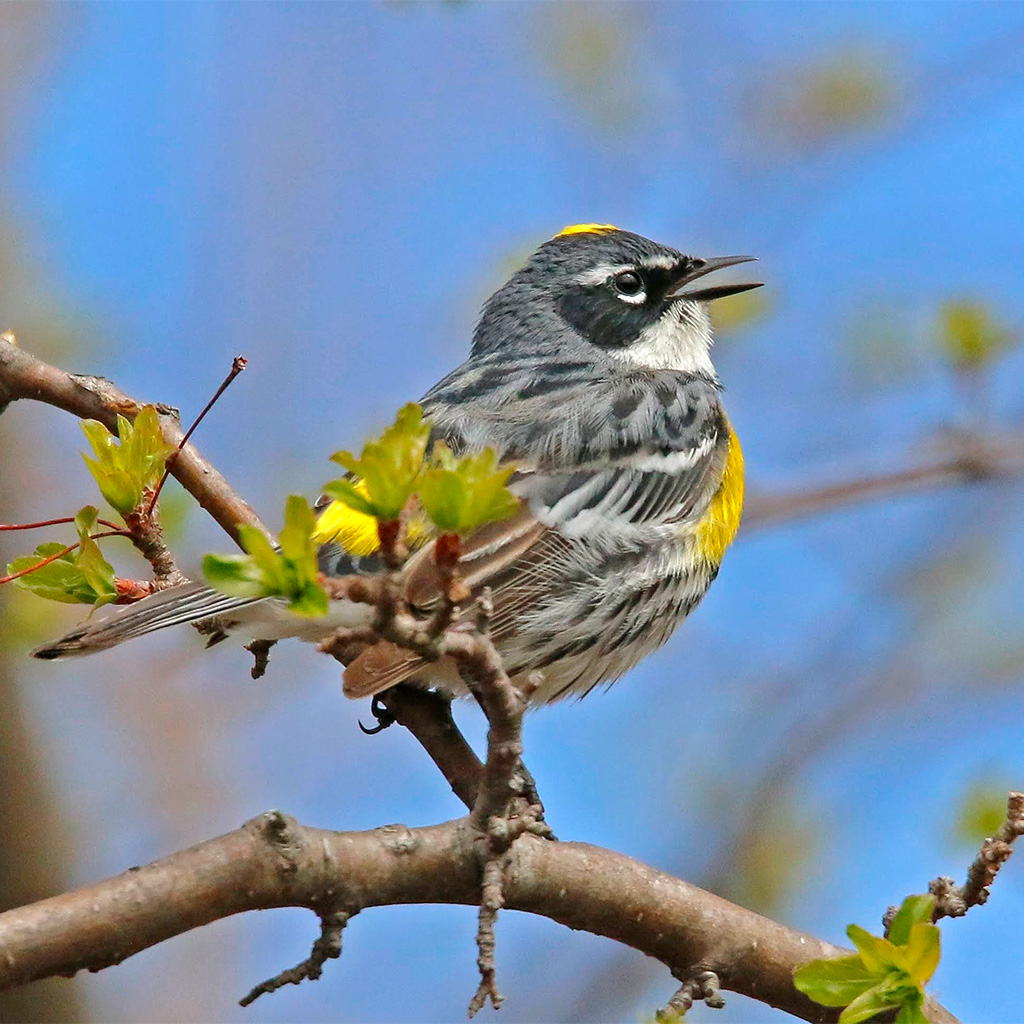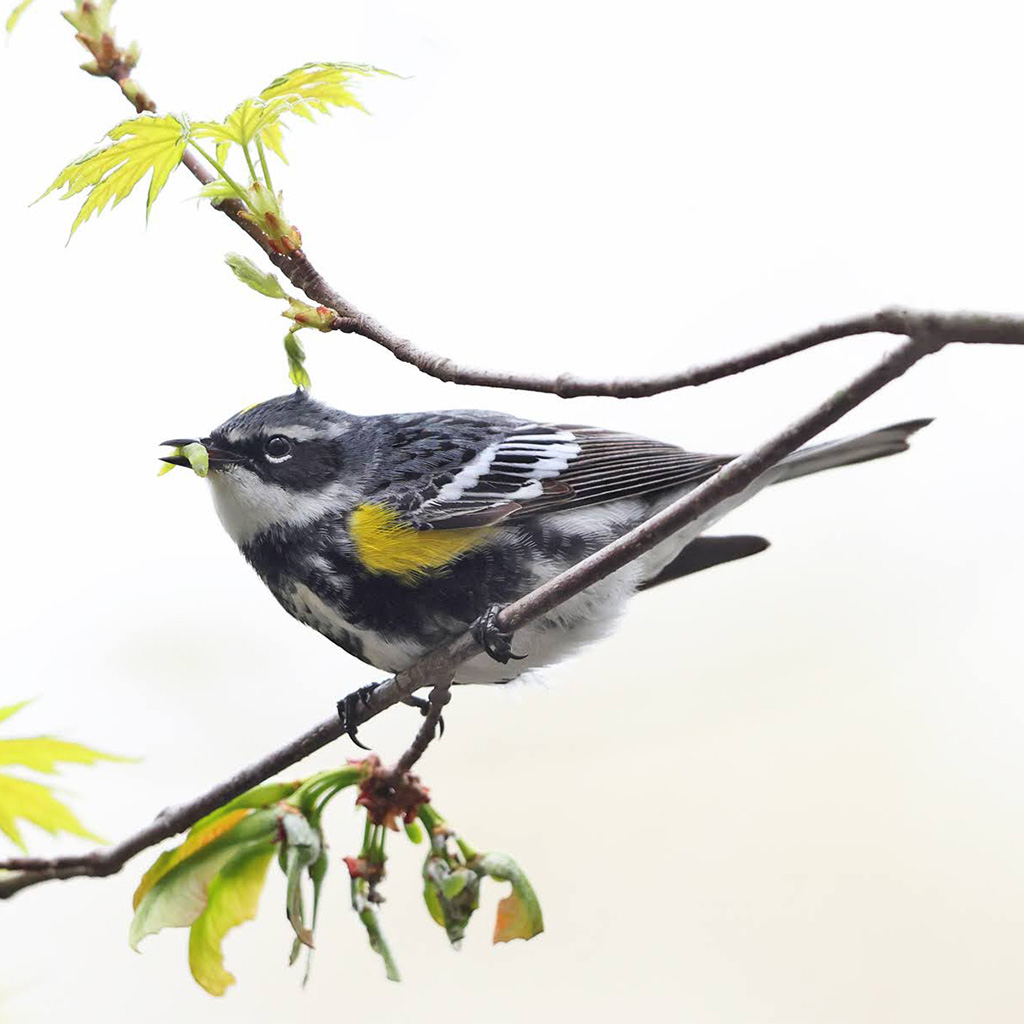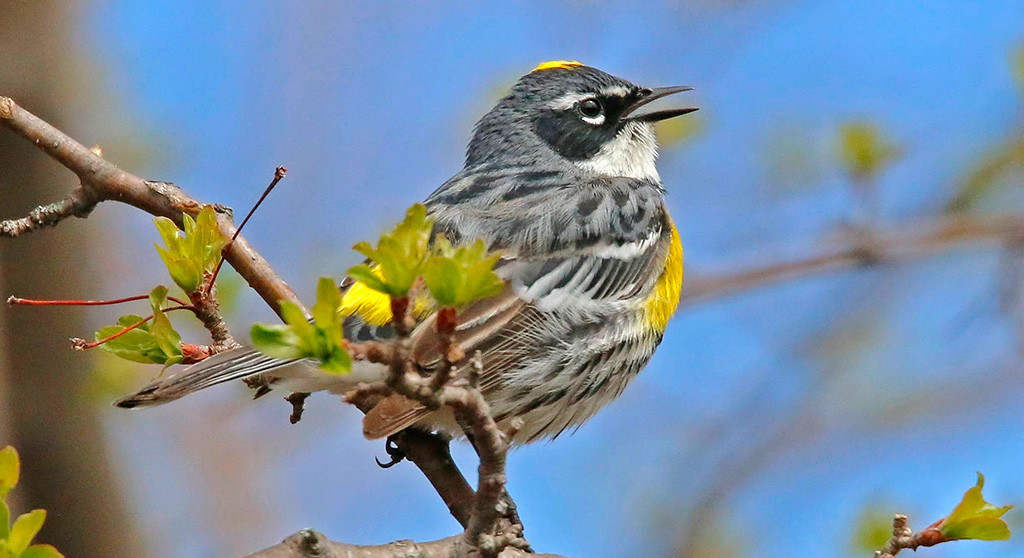Yellow-rumped warbler’s amazing adaptations include efficient air sacs and absorbed intestines

Yellow-rumped warblers may sing to attract mates. (Photo: Paul Wyman)
Warblers are amazing migratory songbirds. Some, such as blackpoll warblers, fly south nonstop over the Atlantic Ocean for days during their fall migration. They fatten up (sometimes doubling their weight) before this trip, which uses a lot of energy. To reduce unneeded weight, they absorb their own intestines, which they don’t need for this arduous flight!
Others, such as golden-winged warblers, can sense tornadoes and severe thunderstorms. They will fly hundreds of miles away from their breeding area several days before such a storm rolls through. Scientists think these birds hear infrasound (low-frequency noise) that the storms produce.

A yellow-rumped warbler with its catch on May 5. (Photo: Tom Murray)
Thirty-five species of warblers visit their their northern summer breeding grounds of Massachusetts each year from as far south as South America. These half-ounce birds are called warblers because of their song. During their migration period – which is now – we might see a dozen different types of warblers, but in this article we are going to focus on one of the most common: the yellow-rumped warbler (Setophaga coronate), affectionately known as the butterbutt. There are about 170 million yellow-rumped warblers in the world, making them one of the most abundant bird species in existence.
Flocks of these tiny birds sweep up along the Eastern Seaboard. The yellow-rumped warbler is the only warbler that can digest the waxes found in some berry coatings. Because of this ability, it can and does winter farther north than other warblers, using berries as an important late season food.

A yellow-rumped warbler eats a juniper berry in Huron Village in October. (Photo: Richard George)

In October, another warbler with a berry depended on as a food source. (Photo: Tom Murray)
In summer, these birds eat mostly insects. You might glimpse them plucking insects from seaweed or manure, skimming insects from rivers or even snatching insects from spiderwebs. Warblers eat a variety of small organisms, including caterpillars, beetles, ants, aphids, grasshoppers, flies, and spiders. When bugs are scarce, it eats juniper berries, poison ivy, grapes, dogwood, and wax myrtle berries.
Yellow-rumped warblers are most often seen in our area during their northern migration in April and May and during their southern migration in September to November. These 5-inch birds are gray with bits of yellow on their face, sides and rump. The yellow color is brightest in the spring. You might be able to attract a yellow-rumped warbler to your yard if you put out sunflower seeds, suet, raisins or peanut butter.

Besides having a yellow spot on the rump, each yellow-rumped warbler has yellow patches on the head and sides. (Photo: Tom Murray)
When yellow-rumped warblers forage with other warblers, they chase away pine and blackburnian warblers, but they ignore palm, magnolia and black-throated green warblers. These active birds breed in higher elevations in Western Massachusetts or just north of Massachusetts in New England and Canada.
Yellow-rumped warblers, like all birds, have a much more efficient respiratory system than humans and other animals. When we breathe in, for example, the fresh oxygen-rich air mixes with stale oxygen-depleted air already in the lungs. Because the air mixes, it contains less oxygen than fresh air alone.

A yellow-rumped warbler forages on the ground in North Cambridge in October 2021. (Photo: Richard George)
When a bird inhales, however, fresh and stale air do not mix. A bird breathes air into rear air sacs. When it exhales, this air goes from the rear air sacs into the lungs, pushing the stale air already in the lungs into front air sacs. Then the bird inhales again. When it exhales again, it breathes out the air from the front air sacs. A breath of oxygen-rich inhaled air stays in the bird respiratory system for two complete inhalation and exhalation cycles before it is exhaled. This adaptation is thought to have developed when dinosaurs – ancestors to birds – lived in a low-oxygen environment and had to breathe very efficiently to survive.
The name “warbler” comes from an Old French word werbler, which means “to sing in trills.” Humans enjoy warbler trilling, but the songs are especially important to female warblers, who choose mates based on the quality of the male’s song.
Next time you have an opportunity to get outside, watch for migrating birds in the canopy of tall trees. But be careful! Holding your neck at a 90-degree angle for too long can cause an overuse injury called warbler neck. But watching these little migrating birds is entirely worth the risk.
![]()
Reader photo

Sue Ratkiewich of Milford, Connecticut, spotted this migrating Baltimore oriole this month.
![]()
Have you taken photos of our urban wild things? Send your images to Cambridge Day, and we may use them as part of a future feature. Include the photographer’s name and the general location where the photo was taken.
Jeanine Farley is an educational writer who has lived in the Boston area for more than 30 years. She enjoys taking photos of our urban wild things.
This post was updated April 26, 2023, to correct the spelling of Jeffrey Offermann’s name.




I’ve seen these around! “Butterbutt” — what a fittingly adorable nickname.